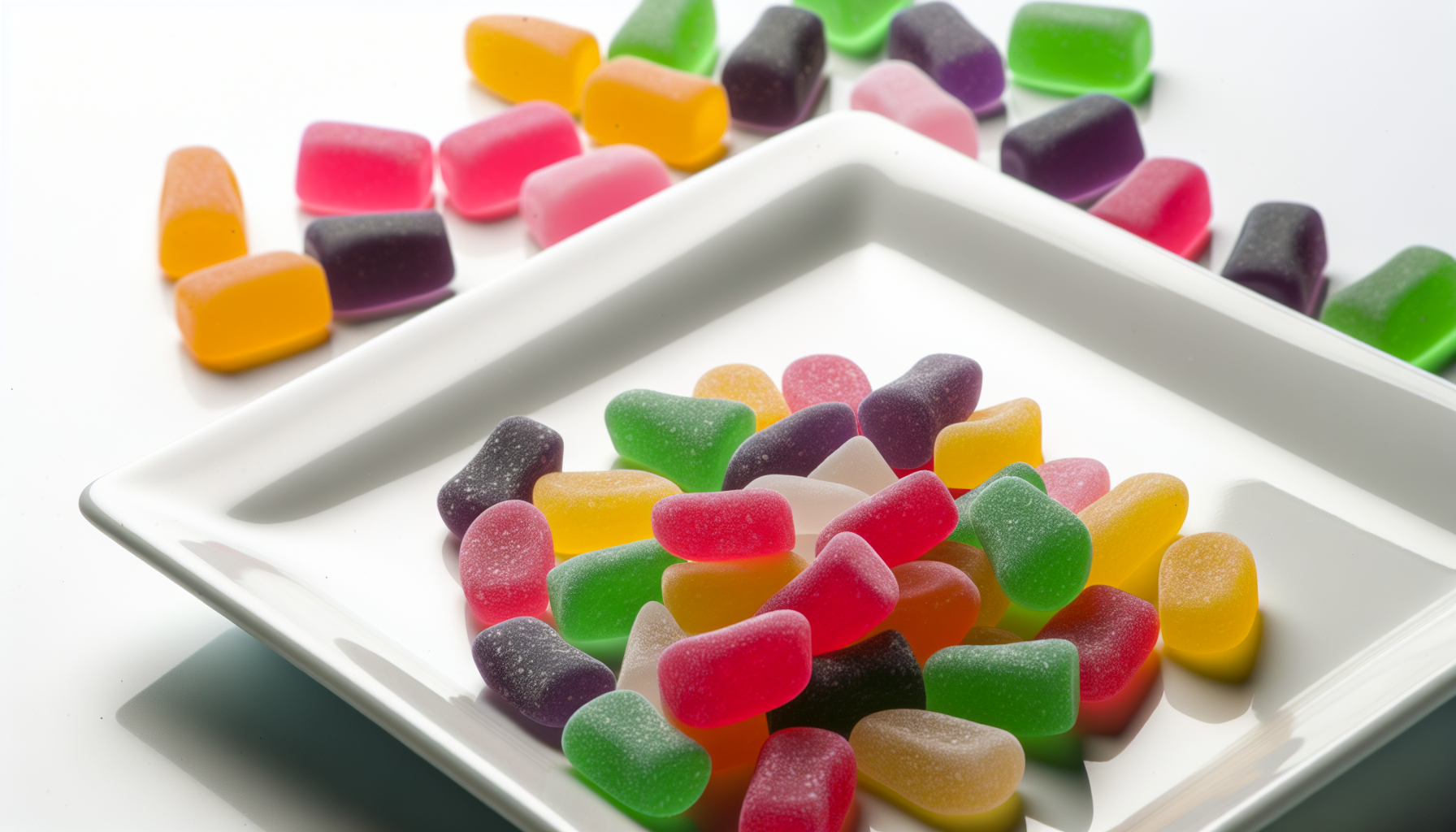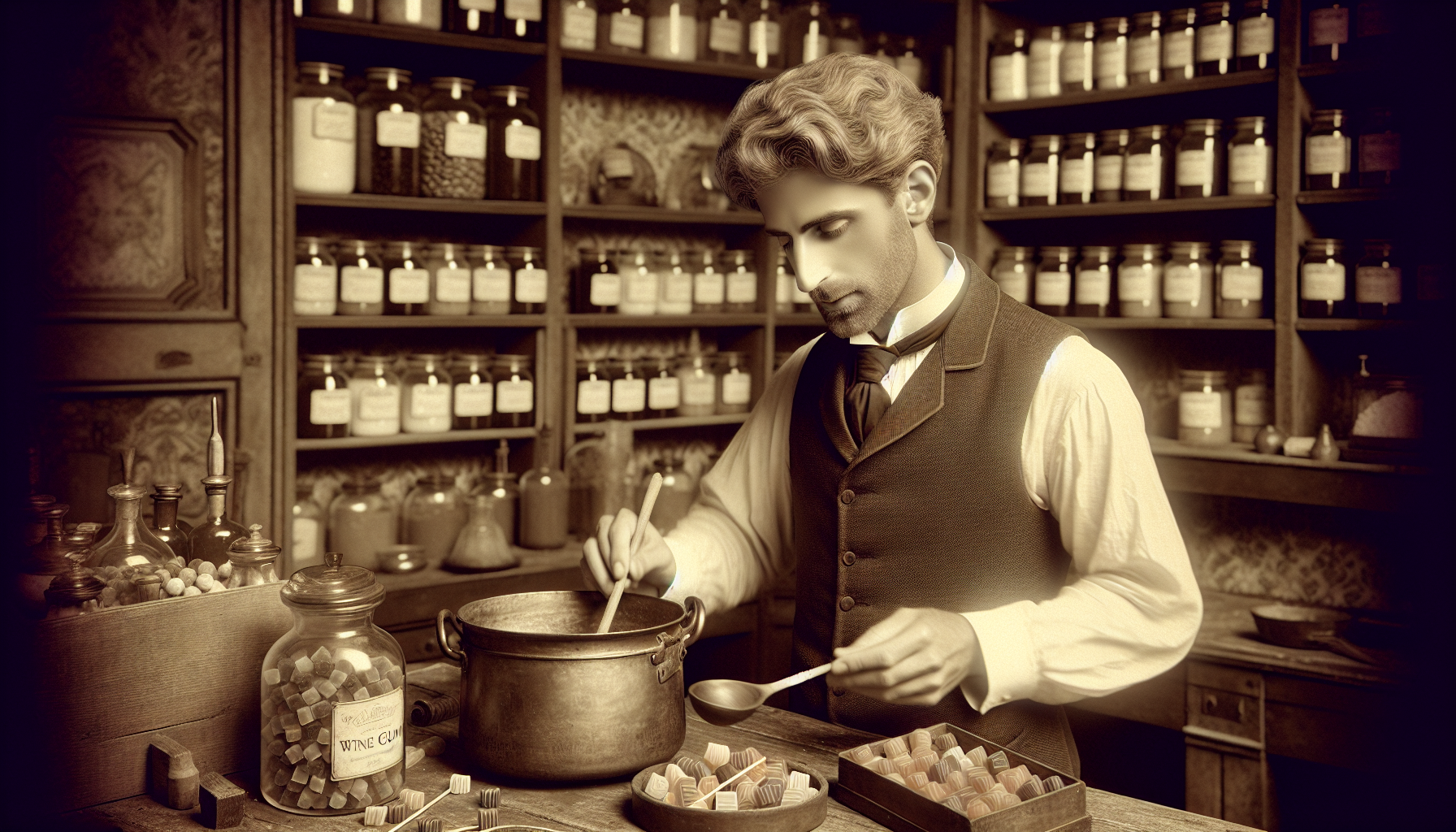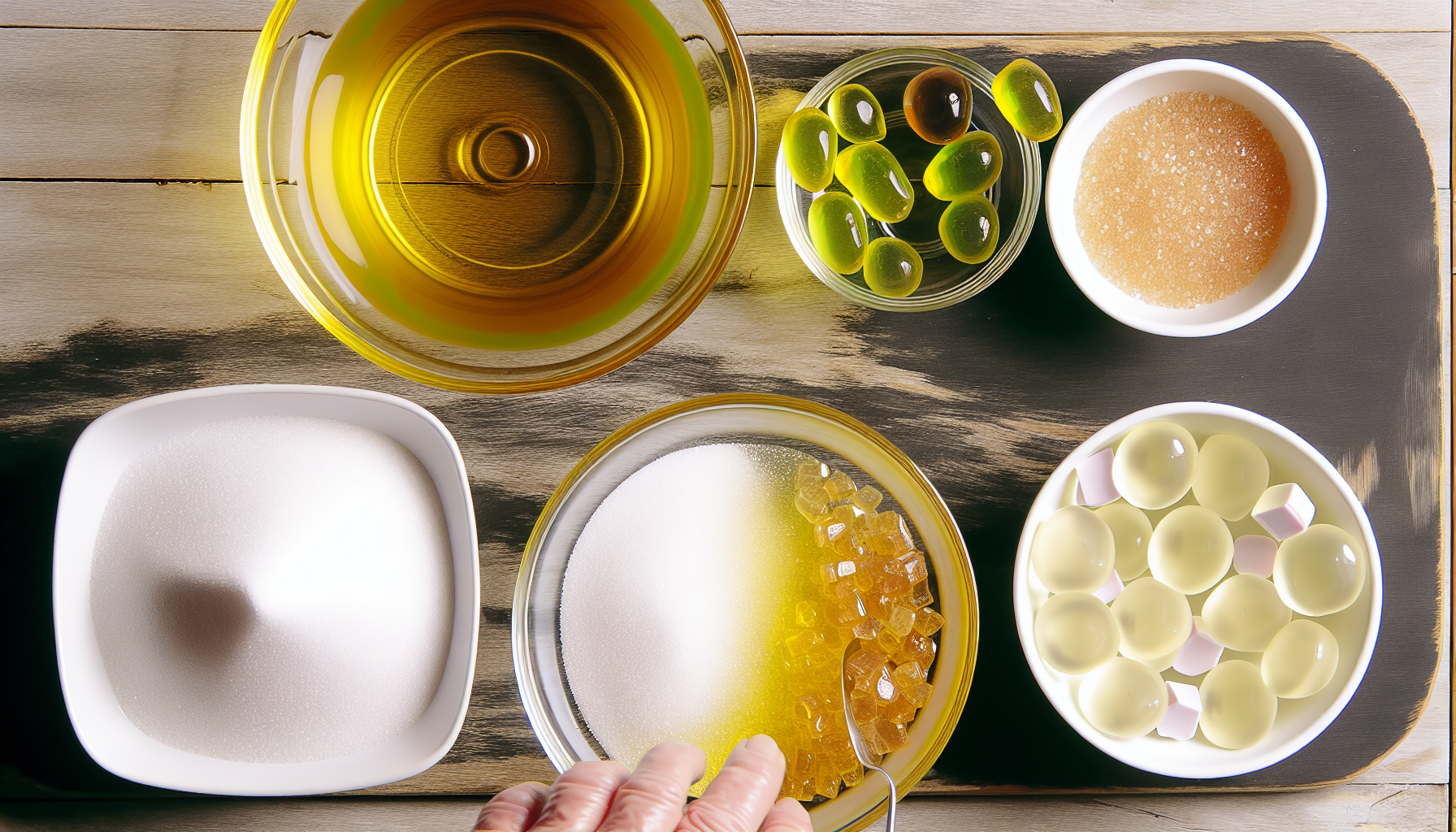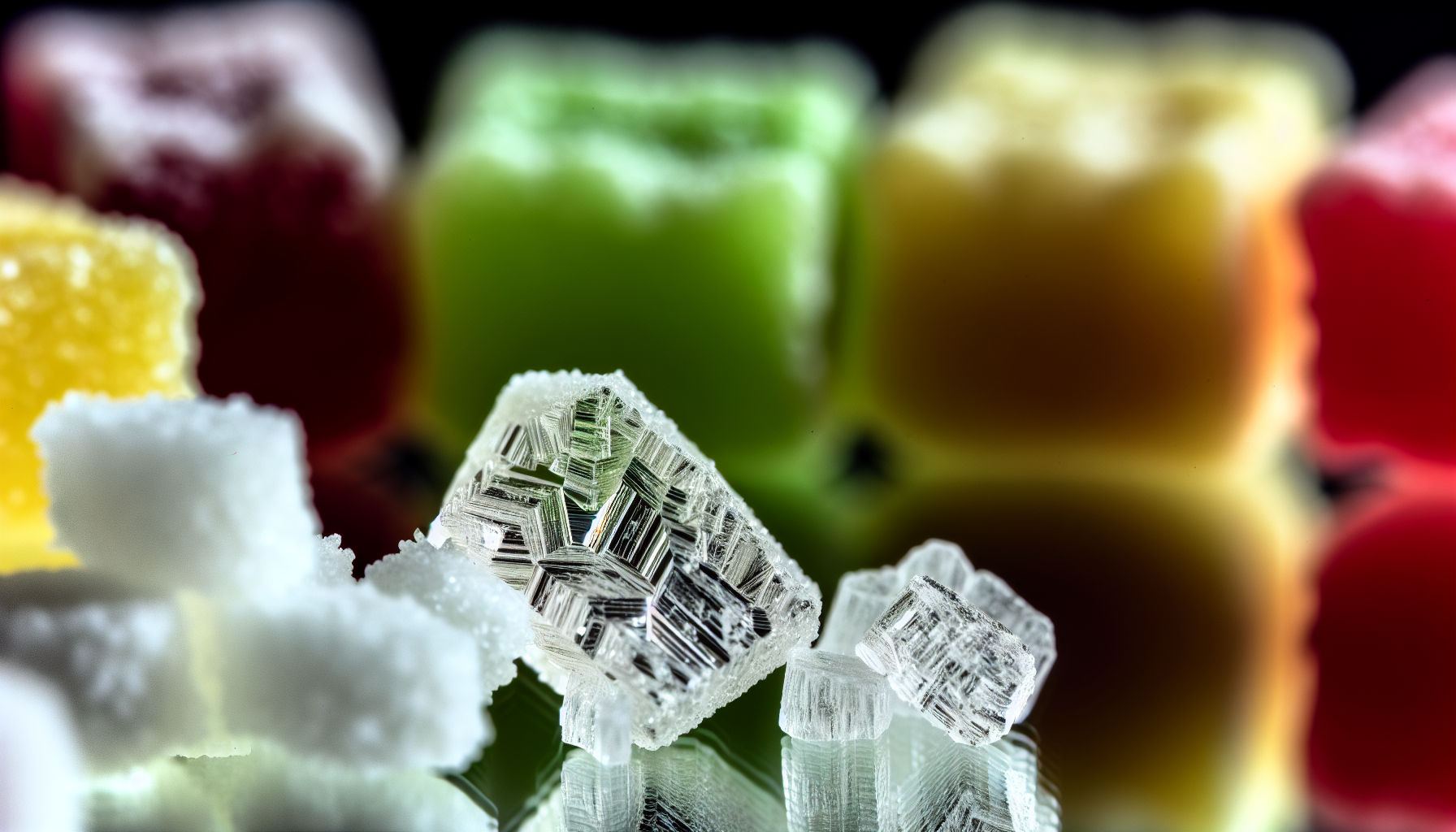Have you ever savored a sweet that teases your palate with a delightful chewy texture and a symphony of fruity flavors? If not, let us take you on a tantalizing journey through the world of wine gums, a British confectionery delight that has been tickling taste buds for over a century. But first, let’s answer the question: what are wine gums?
Key Takeaways
- Wine gums are chewy, alcohol-free confections that contain a range of natural fruit flavors.
- Their texture is defined by a mix of ingredients creating an enhanced chewiness compared to other gummies.
- Enjoyed casually or paired with fine wine, they offer unique flavor and texture experiences while being mindful of their sugar content.
Unwrapping the Mystery: What Exactly Are Wine Gums?

Wine gums, despite their name, are alcohol-free chewy treats that have successfully enamored sweet enthusiasts worldwide. So, what exactly are these enticing confections? Originating from the confectionery labs of Maynards, wine gums are a delightful paradox – a non-alcoholic sweet that mimics the experience of savoring various types of wine.
Some key features of wine gums include:
- Chewy texture
- Assorted flavors, often inspired by different types of wine
- No actual wine content
- Popular in the UK and other countries
Whether you’re a fan of wine or not, wine gums offer a unique and enjoyable candy experience.
Each wine gum is a burst of delectable fruit flavors, including citric acid-rich options such as:
- Cherry
- Raspberry
- Lemon
- Orange
- Lime
- Blackcurrant
The flavors, derived from natural flavours, are carefully curated and integrated during the making of wine gums, creating a refined flavour profile that’s uniquely refreshing.
The ‘wine gums’ moniker pays homage to their origin, embodying the more refined flavour they provide, reminiscent of fermented wine tasting experiences, hence the name.
Over the years, they have become recognisable sweets and a staple in the confectionery world.
The Texture That Defines Wine Gums
A discussion about wine gums is incomplete without acknowledging their unique texture – thicker, chewier, and more gelatinous than their gummy counterparts. This texture is a result of the use of gelatine in their production. The texture of wine gums can vary slightly between different brands, with some offering a firmer consistency while others lean towards a softer chew.
The distinctive chewiness of wine gums stems from a meticulously balanced mix of ingredients. Glucose syrup, gelatin, and corn starch come together to bind the candy, yielding a smooth and delightfully chewy texture. The result is a sweet treat that’s a joy to savor, with a satisfyingly firm bite that sets it apart from other gummy candies.
The Rainbow of Flavours in Every Pack
Every pack of wine gums is a veritable rainbow of flavors. Each color of these chewy treats represents a different fruit flavor:
- Cherry for red
- Raspberry for pink
- Lemon for yellow
- Orange for orange
- Blackcurrant for black
This range of flavors adds an element of surprise and excitement with every bite, making the experience of eating wine gums truly unique.
While the name suggests a connection with wine, not all wine gum flavors are inspired by actual wine varieties. The name ‘wine gums’ is derived from the intent that these flavors be savored similarly to wine. The flavors are created using a combination of natural and artificial flavorings, which are then incorporated into the gum mixture during production, giving each wine gum its distinctive taste.
Why They’re Called Wine Gums Despite No Alcohol
Contrary to what their name may suggest, wine gums are completely alcohol-free. The name ‘wine gums’ is an echo of their original purpose. They were crafted to provide an experience akin to savoring fine wine, without the alcohol content. The lingering texture of these gums is another reason they were named ‘wine gums’.
One popular theory suggests that Charles Gordon Maynard, the progenitor of Maynard’s, named them wine gums as he designated them with vinous appellations. Another theory suggests that each hue of the wine gums symbolizes a distinctive variety of wine. Regardless of the theory, it’s clear that wine gums have carved a unique niche in the confectionery world, offering an experience that goes beyond their alcohol-free content.
The Sweet Invention: Charles Gordon Maynard and the Birth of a Classic

The inception of wine gums can be traced back to 1880, credited to Charles Gordon Maynard. He was the son of Charles Riley Maynard, who started a confectionery venture in partnership with his brother Tom in Stamford Hill, London. Charles Gordon Maynard conceived the idea of wine gums with an aspiration to create a confection that could be relished in a manner similar to a high-quality wine.
Within six years of their inception, wine gums had become a beloved treat across England. The popularity of these chewy sweets can be largely attributed to the Maynard’s company, which still exists today. Charles Gordon Maynard’s innovative creation had a significant impact on the English confectionery market in the 1880s.
From its humble beginnings as a family business, Maynard’s Sweets has grown into a global sensation. Today, wine gums are enjoyed by people all over the world, making them a classic in the world of confections.
The Early Days of Maynards Sweets
Maynards Sweets’ success story stands as a beacon of innovation and perseverance. The company was founded in 1896 by Charles Riley Maynard, and initially, they produced sweets with names such as:
- Sherry
- Port
- Champagne
- Burgundy
- Claret
The company started as a modest sweet shop in the Stamford Hill section of North London, but their ambition did not stop there.
To expand their reach, Maynards established a portfolio of sweet shops. In 1985, these shops were sold, and in 1988, Cadbury acquired Maynards Sweets. Despite several changes in ownership since the 1960s, Maynards Sweets has continued to be credited with the invention of wine gums, a testament to the lasting impact of Charles Gordon Maynard’s sweet invention.
From Family Business to Global Sensation
The journey of wine gums from a family business to a global sensation is truly inspiring. Maynards implemented strategies such as:
- Forming a strong and consistent brand culture
- Executing borderless marketing
- Establishing internal hubs
- Constructing a ‘glocal’ structure
As a result, Maynards wine gums are now sold in various countries including the United Kingdom, Canada, Ireland, South Africa, several Commonwealth nations, and some European countries.
Cultural preferences played a significant role in the marketing and packaging of Maynards wine gums in different countries. They were positioned as a high-class candy for a low cost and were related to wine tasting. The packaging typically features five shapes, making them instantly recognizable:
- Kidney
- Crown
- Diamond
- Circle
- Rectangle
The Making of a Wine Gum: Ingredients and Process

Creating a wine gum demands meticulousness, precision, and a keen attention to detail. A blend of ingredients including glucose syrup, sugar, and gelatine is combined to create a dense syrup. This syrup is then shaped into the preferred gum shape, offering each wine gum its unique texture and shape. The process of making wine gums is truly an art form.
The ingredients involved in producing wine gums contribute more than just the desired texture and shape. They also play a crucial role in determining the taste of the candy. For instance, glucose syrup is used as a sweetening agent, while gelatine gives the candy its chewy texture.
The final step in the making of wine gums involves coating them in a glazing agent, such as carnauba wax or beeswax, and packaging them for sale. Beeswax is typically used as the glazing agent, giving the candies a glossy look and helping to maintain their freshness. Each candy is then meticulously packaged, ready to be shipped off to sweet lovers around the world.
A Blend of Sweetness and Texture
The ingredients in wine gums create a perfect balance of sweetness and chewy texture. The primary components of wine gums are sugar, gelatine, and cornstarch. These ingredients are carefully combined to confer the desired texture and sweetness to the candies. This harmonious blend of ingredients results in a confection that is both sweet and satisfyingly chewy.
Gelatine, in particular, plays a crucial role in the texture of wine gums. It provides a chewy texture and assists in forming the firm and gummy consistency that wine gums are renowned for. Additionally, the sweet taste receptors on our tongue are activated by sugars and sweeteners, augmenting the overall taste of the wine gums.
Shaping the Chewy Treats
Shaping wine gums is a delicate process that requires skill and precision. The wine gum mixture is poured into molds to create the desired shape. These molds are typically made from corn starch, which allows for easy extraction of the wine gums without compromising their shape.
Each wine gum is carefully shaped into one of the five classic shapes:
- kidney
- crown
- diamond
- circle
- rectangle
This gives each wine gum its distinctive look, making it instantly recognizable to sweet lovers worldwide. The result is a perfectly shaped wine gum, ready to be enjoyed.
The Finishing Touch: Coating and Packaging
The final step in the making of wine gums is coating and packaging. Each wine gum is coated with a thin layer of beeswax, which serves as a glazing agent. This gives the candies a glossy look and helps maintain their freshness.
The wine gums are then packaged, ready to be distributed to stores worldwide. The packaging is designed to keep the wine gums fresh and protect them from damage during transit. Despite the lack of specific details on the packaging materials, it is clear that the packaging process is a crucial step in ensuring that each wine gum reaches the consumer in perfect condition.
Indulging Responsibly: Health Considerations When You Eat Wine Gums

Although wine gums are unquestionably delightful, responsible indulgence is crucial. They are high in sugar, and therefore, their consumption should be moderated. However, they can be included as part of a balanced diet, offered they are consumed in moderation.
A serving of wine gums typically contains approximately 16 grams of sugar. Therefore, it’s crucial to take into account the sugar content when incorporating them into your diet. Moreover, due to their sticky nature, wine gums may have a negative influence on dental health. Hence, maintaining good oral hygiene is essential when you enjoy these chewy treats.
Even with their sugar content, wine gums can still be a delightful treat, given they are consumed responsibly. Their low-fat and salt content makes them a suitable snack for those who are mindful of their dietary intake. However, like any other sweet treat, the key is moderation and balance.
Sugar Content and Dietary Implications
Consider the sugar content in wine gums before incorporating them into your dietary plan. A serving of wine gums typically contains approximately 24 grams of sugar. Therefore, if there are dietary restrictions on sugar intake, it is advisable to consume them in moderation.
Diabetics, in particular, should be aware of the sugar content when consuming wine gums. High sugar foods can cause a spike in blood sugar levels, and it’s important to limit the intake of sugary foods to maintain stable blood sugar levels. Moreover, some wine gums may contain sugar alcohols, which should also be taken into account when managing the diet.
Choosing the Best Wine Gums for Your Lifestyle
There are a variety of wine gum brands available, catering to different dietary needs and preferences. The healthiest wine gum options available include those that are sugar-free, made with natural ingredients, and contain superfoods such as polyphenols.
When selecting wine gums based on dietary restrictions, it’s essential to read the product labels and ingredient lists to ensure that the wine gums meet your specific needs. Factors such as:
- Sugar content
- Vegan-friendly options
- Allergen-free options
- Alcohol content
should be taken into account.
Pairing and Enjoyment: When and How to Serve Wine Gums
Wine gums, beyond being simply a sweet treat, offer versatile indulgence that can be savored in multiple ways. Whether you’re enjoying them as a casual snack or pairing them with a glass of fine wine for a sophisticated culinary experience, wine gums are a delight to savor.
Wine gums can be enjoyed in various ways:
- Served at a party or gathering as a complement to savory snacks such as nuts or chips
- Enjoyed in conjunction with moderately dry wines
- Enjoyed anytime, anywhere – from long flights to a quiet evening at home
Wine gums are a perfect companion for any occasion.
Moreover, pairing wine gums with moderately dry wines can enhance the flavors of both the candy and the wine. Wines with bright fruit flavors, such as zesty white wines, rosé, and Pinot Noir, are best suited for pairing with wine gums.
The Casual Snack: Enjoying Wine Gums Anytime
Wine gums, with their versatility, make for a treat that can be enjoyed at any time and any place. Their low fat and salt content, coupled with their unique taste and texture, make them a popular choice for a casual snack. In fact, wine gums are enjoyed by adults due to their less sweet and more nuanced flavor, making them a suitable snack for any time of the day.
When it comes to storage and packaging for on-the-go convenience, wine gums are quite flexible. They can be stored at room temperature without deterioration. However, it’s not advisable to store them in hot and humid conditions. Instead, it’s recommended to store them in a cool and dry area.
Elevating the Experience: Wine Gums and Fine Wine
For those looking to elevate their culinary experience, pairing wine gums with fine wine can be a delightful option. The theory behind this pairing is based on understanding the structural components of the food and how they interact with the flavors and characteristics of the wine. For instance, wines with bright fruit flavors, such as zesty white wines, rosé, and Pinot Noir, are best suited for pairing with wine gums.
Whether it’s a family gathering or a dinner party with friends, serving wine gums with a well-chosen wine can create a memorable culinary experience. So, the next time you’re planning to enjoy some fine wine, consider pairing it with a handful of wine gums. The unique blend of flavors might just surprise you.
Beyond the Basics: Other Brands and Alternatives to Maynards Wine Gums

Despite Maynards being the pioneer of wine gums, numerous other brands have also established their presence in the market. Each brand brings something unique to the table, offering a variety of options for consumers. Some of the renowned brands, apart from Maynards, include:
- Haribo
- Lion
- Taveners
- De Bron
Each brand has its unique offerings. For instance:
- Haribo wine gums are known for their soft and chewy texture and a variety of fruit flavors.
- Lion wine gums are recognized for their chewy texture and special flavor.
- Taveners offer unique flavors like cherry, raspberry, blackcurrant, orange, lemon, and more.
In addition to other brands of wine gums, there are also alternative chewy sweets available for those who wish to explore beyond wine gums. These include:
- Gummy bears
- Jelly beans
- Fruit pastilles
- Jelly babies
- American hard gums
Each of these alternatives offers a unique taste and texture, providing a delightful variety for sweet lovers.
Exploring the Competition: Haribo, Lion, and More
Exploring the competition in the world of wine gums can open up a delightful array of choices. Haribo wine gums, for instance, are known for their soft and chewy texture and a variety of fruit flavors. Each Haribo wine gum is a burst of flavor, making it a popular choice among sweet lovers.
On the other hand, Lion wine gums are renowned for their chewy texture and unique flavor. They offer a different experience compared to Maynards wine gums, making them a delightful alternative. Taveners, another brand, offers a variety of unique flavors like cherry, raspberry, blackcurrant, orange, lemon, and more.
Alternative Chewy Sweets
For those interested in venturing beyond wine gums, a variety of alternative chewy sweets are available. These include:
- Gummy bears
- Jelly beans
- Fruit pastilles
- Jelly babies
- American hard gums
Each of these alternatives, including coconut oil-based treats, offers a unique taste and texture, providing a delightful variety for sweet lovers.
Some popular types of candies include:
- Gummy bears
- Jelly beans
- Wine gums
- Fruit pastilles
- Jelly babies
Gummy bears and jelly beans, for instance, are softer and more pliable compared to wine gums. They are also available in a variety of flavors, making them a popular alternative. On the other hand, fruit pastilles and jelly babies offer a different texture and are composed of different ingredients, offering a unique taste experience.
Summary
In conclusion, wine gums are a unique confectionery delight that has stood the test of time. From their invention by Charles Gordon Maynard to their evolution into a global sensation, wine gums have captivated sweet lovers with their distinctive chewy texture and array of fruit flavors. Despite their name, wine gums don’t contain any alcohol, making them a suitable treat for people of all ages.
Whether enjoyed as a casual snack or paired with fine wine, wine gums offer a versatile and delightful culinary experience. While Maynards may be the original creator of wine gums, other brands like Haribo, Lion, and Taveners, as well as alternative chewy sweets, offer a delightful array of choices for consumers. So, the next time you’re craving a sweet treat, consider reaching for a pack of wine gums and savor the unique blend of flavors and textures.
Frequently Asked Questions
Why do they call it wine gums?
Wine gums get their name from the fermented wine used to make them when they were first created by Charles Gordon Maynard in 1909. These chewy treats come in a range of flavours and are a popular British sweet.
Do wine gums actually have alcohol?
No, wine gums do not contain alcohol – the creator of these sweets came from a strict Methodist household and was almost fired when they heard he was selling something with ‘wine’ in the name.
Are wine gums like gummy bears?
Wine gums have a similar consistency to gummy bears, but are much chewier. Although widely available in the UK and other British countries, it is harder to find them in the US.
What are wine gums?
Wine gums are a popular British confectionery renowned for their chewy texture and array of fruit flavors – all without any alcohol or fermented wine.
Who invented wine gums?
Charles Gordon Maynard is credited with inventing wine gums, being the son of a sweet shop owner.

